Wenzhuo Yang
MCP-Universe: Benchmarking Large Language Models with Real-World Model Context Protocol Servers
Aug 20, 2025Abstract:The Model Context Protocol has emerged as a transformative standard for connecting large language models to external data sources and tools, rapidly gaining adoption across major AI providers and development platforms. However, existing benchmarks are overly simplistic and fail to capture real application challenges such as long-horizon reasoning and large, unfamiliar tool spaces. To address this critical gap, we introduce MCP-Universe, the first comprehensive benchmark specifically designed to evaluate LLMs in realistic and hard tasks through interaction with real-world MCP servers. Our benchmark encompasses 6 core domains spanning 11 different MCP servers: Location Navigation, Repository Management, Financial Analysis, 3D Design, Browser Automation, and Web Searching. To ensure rigorous evaluation, we implement execution-based evaluators, including format evaluators for agent format compliance, static evaluators for time-invariant content matching, and dynamic evaluators that automatically retrieve real-time ground truth for temporally sensitive tasks. Through extensive evaluation of leading LLMs, we find that even SOTA models such as GPT-5 (43.72%), Grok-4 (33.33%) and Claude-4.0-Sonnet (29.44%) exhibit significant performance limitations. In addition, our benchmark poses a significant long-context challenge for LLM agents, as the number of input tokens increases rapidly with the number of interaction steps. Moreover, it introduces an unknown-tools challenge, as LLM agents often lack familiarity with the precise usage of the MCP servers. Notably, enterprise-level agents like Cursor cannot achieve better performance than standard ReAct frameworks. Beyond evaluation, we open-source our extensible evaluation framework with UI support, enabling researchers and practitioners to seamlessly integrate new agents and MCP servers while fostering innovation in the rapidly evolving MCP ecosystem.
Deep Learning Approaches for Anti-Money Laundering on Mobile Transactions: Review, Framework, and Directions
Mar 13, 2025Abstract:Money laundering is a financial crime that obscures the origin of illicit funds, necessitating the development and enforcement of anti-money laundering (AML) policies by governments and organizations. The proliferation of mobile payment platforms and smart IoT devices has significantly complicated AML investigations. As payment networks become more interconnected, there is an increasing need for efficient real-time detection to process large volumes of transaction data on heterogeneous payment systems by different operators such as digital currencies, cryptocurrencies and account-based payments. Most of these mobile payment networks are supported by connected devices, many of which are considered loT devices in the FinTech space that constantly generate data. Furthermore, the growing complexity and unpredictability of transaction patterns across these networks contribute to a higher incidence of false positives. While machine learning solutions have the potential to enhance detection efficiency, their application in AML faces unique challenges, such as addressing privacy concerns tied to sensitive financial data and managing the real-world constraint of limited data availability due to data regulations. Existing surveys in the AML literature broadly review machine learning approaches for money laundering detection, but they often lack an in-depth exploration of advanced deep learning techniques - an emerging field with significant potential. To address this gap, this paper conducts a comprehensive review of deep learning solutions and the challenges associated with their use in AML. Additionally, we propose a novel framework that applies the least-privilege principle by integrating machine learning techniques, codifying AML red flags, and employing account profiling to provide context for predictions and enable effective fraud detection under limited data availability....
Efficient Dataset Distillation through Alignment with Smooth and High-Quality Expert Trajectories
Oct 16, 2023Abstract:Training a large and state-of-the-art machine learning model typically necessitates the use of large-scale datasets, which, in turn, makes the training and parameter-tuning process expensive and time-consuming. Some researchers opt to distil information from real-world datasets into tiny and compact synthetic datasets while maintaining their ability to train a well-performing model, hence proposing a data-efficient method known as Dataset Distillation (DD). Despite recent progress in this field, existing methods still underperform and cannot effectively replace large datasets. In this paper, unlike previous methods that focus solely on improving the efficacy of student distillation, we are the first to recognize the important interplay between expert and student. We argue the significant impact of expert smoothness when employing more potent expert trajectories in subsequent dataset distillation. Based on this, we introduce the integration of clipping loss and gradient penalty to regulate the rate of parameter changes in expert trajectories. Furthermore, in response to the sensitivity exhibited towards randomly initialized variables during distillation, we propose representative initialization for synthetic dataset and balanced inner-loop loss. Finally, we present two enhancement strategies, namely intermediate matching loss and weight perturbation, to mitigate the potential occurrence of cumulative errors. We conduct extensive experiments on datasets of different scales, sizes, and resolutions. The results demonstrate that the proposed method significantly outperforms prior methods.
PyRCA: A Library for Metric-based Root Cause Analysis
Jun 20, 2023Abstract:We introduce PyRCA, an open-source Python machine learning library of Root Cause Analysis (RCA) for Artificial Intelligence for IT Operations (AIOps). It provides a holistic framework to uncover the complicated metric causal dependencies and automatically locate root causes of incidents. It offers a unified interface for multiple commonly used RCA models, encompassing both graph construction and scoring tasks. This library aims to provide IT operations staff, data scientists, and researchers a one-step solution to rapid model development, model evaluation and deployment to online applications. In particular, our library includes various causal discovery methods to support causal graph construction, and multiple types of root cause scoring methods inspired by Bayesian analysis, graph analysis and causal analysis, etc. Our GUI dashboard offers practitioners an intuitive point-and-click interface, empowering them to easily inject expert knowledge through human interaction. With the ability to visualize causal graphs and the root cause of incidents, practitioners can quickly gain insights and improve their workflow efficiency. This technical report introduces PyRCA's architecture and major functionalities, while also presenting benchmark performance numbers in comparison to various baseline models. Additionally, we demonstrate PyRCA's capabilities through several example use cases.
AI for IT Operations on Cloud Platforms: Reviews, Opportunities and Challenges
Apr 10, 2023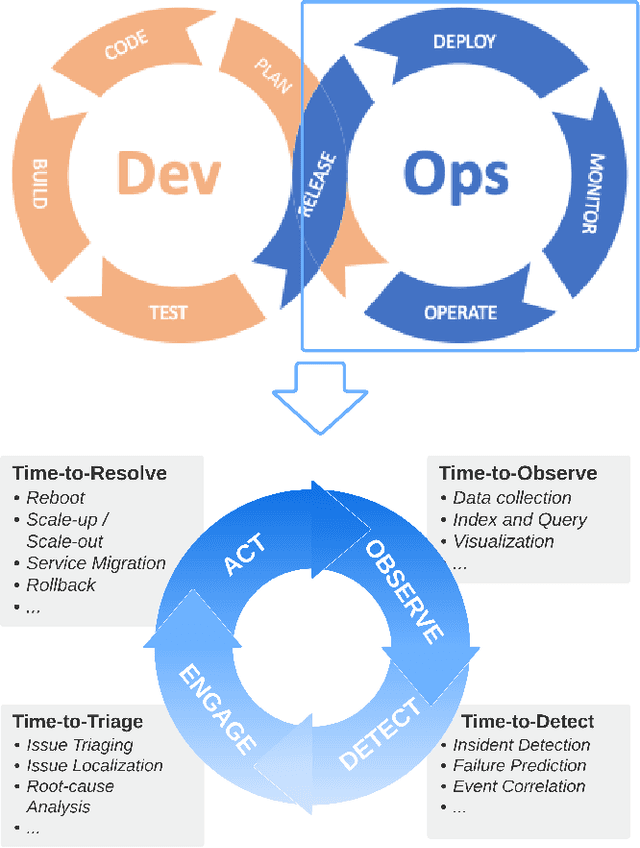
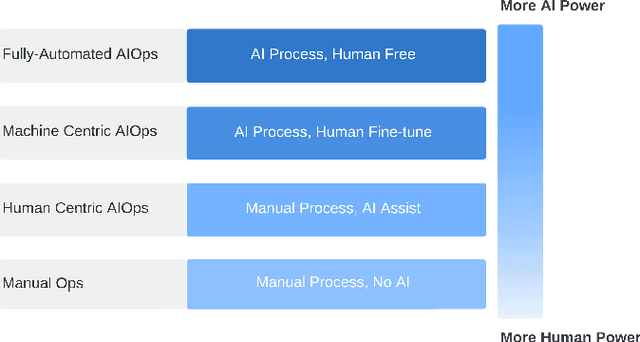

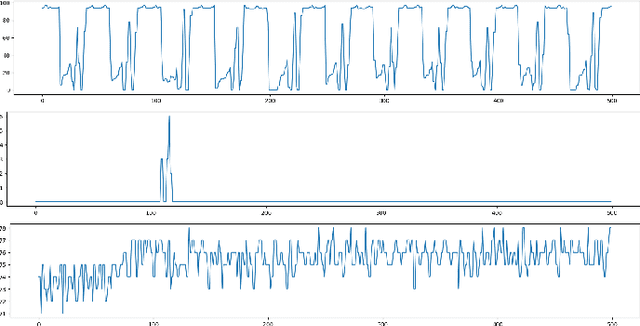
Abstract:Artificial Intelligence for IT operations (AIOps) aims to combine the power of AI with the big data generated by IT Operations processes, particularly in cloud infrastructures, to provide actionable insights with the primary goal of maximizing availability. There are a wide variety of problems to address, and multiple use-cases, where AI capabilities can be leveraged to enhance operational efficiency. Here we provide a review of the AIOps vision, trends challenges and opportunities, specifically focusing on the underlying AI techniques. We discuss in depth the key types of data emitted by IT Operations activities, the scale and challenges in analyzing them, and where they can be helpful. We categorize the key AIOps tasks as - incident detection, failure prediction, root cause analysis and automated actions. We discuss the problem formulation for each task, and then present a taxonomy of techniques to solve these problems. We also identify relatively under explored topics, especially those that could significantly benefit from advances in AI literature. We also provide insights into the trends in this field, and what are the key investment opportunities.
LogAI: A Library for Log Analytics and Intelligence
Jan 31, 2023
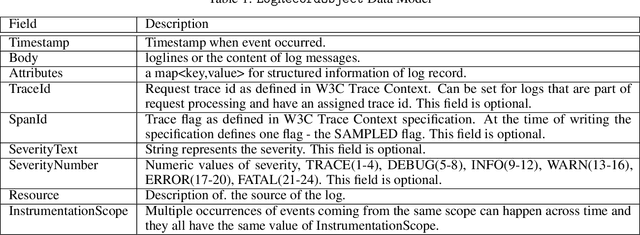
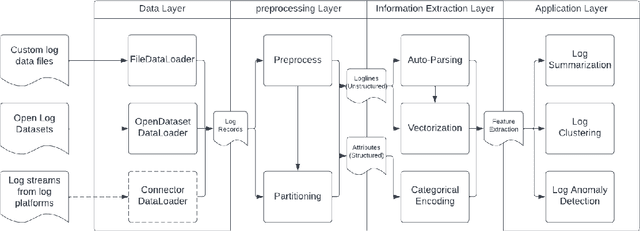
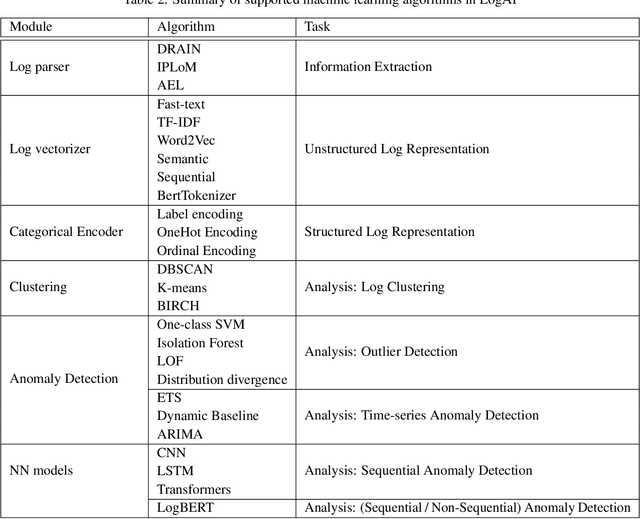
Abstract:Software and System logs record runtime information about processes executing within a system. These logs have become the most critical and ubiquitous forms of observability data that help developers understand system behavior, monitor system health and resolve issues. However, the volume of logs generated can be humongous (of the order of petabytes per day) especially for complex distributed systems, such as cloud, search engine, social media, etc. This has propelled a lot of research on developing AI-based log based analytics and intelligence solutions that can process huge volume of raw logs and generate insights. In order to enable users to perform multiple types of AI-based log analysis tasks in a uniform manner, we introduce LogAI (https://github.com/salesforce/logai), a one-stop open source library for log analytics and intelligence. LogAI supports tasks such as log summarization, log clustering and log anomaly detection. It adopts the OpenTelemetry data model, to enable compatibility with different log management platforms. LogAI provides a unified model interface and provides popular time-series, statistical learning and deep learning models. Alongside this, LogAI also provides an out-of-the-box GUI for users to conduct interactive analysis. With LogAI, we can also easily benchmark popular deep learning algorithms for log anomaly detection without putting in redundant effort to process the logs. We have opensourced LogAI to cater to a wide range of applications benefiting both academic research and industrial prototyping.
Salesforce CausalAI Library: A Fast and Scalable Framework for Causal Analysis of Time Series and Tabular Data
Jan 25, 2023



Abstract:We introduce the Salesforce CausalAI Library, an open-source library for causal analysis using observational data. It supports causal discovery and causal inference for tabular and time series data, of both discrete and continuous types. This library includes algorithms that handle linear and non-linear causal relationships between variables, and uses multi-processing for speed-up. We also include a data generator capable of generating synthetic data with specified structural equation model for both the aforementioned data formats and types, that helps users control the ground-truth causal process while investigating various algorithms. Finally, we provide a user interface (UI) that allows users to perform causal analysis on data without coding. The goal of this library is to provide a fast and flexible solution for a variety of problems in the domain of causality. This technical report describes the Salesforce CausalAI API along with its capabilities, the implementations of the supported algorithms, and experiments demonstrating their performance and speed. Our library is available at \url{https://github.com/salesforce/causalai}.
Causality-Based Multivariate Time Series Anomaly Detection
Jun 30, 2022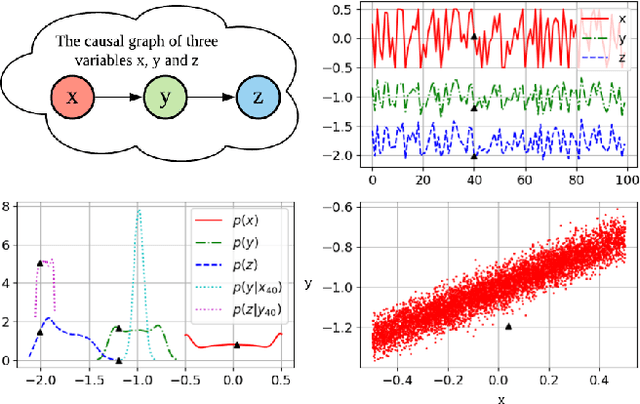

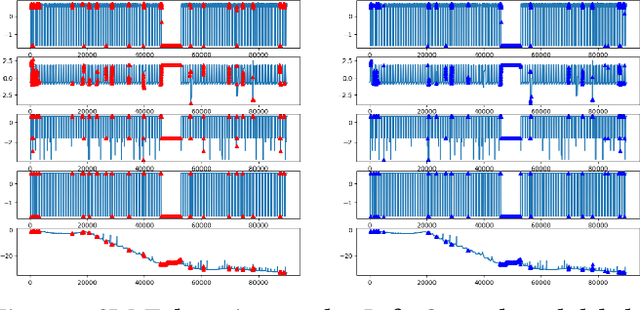
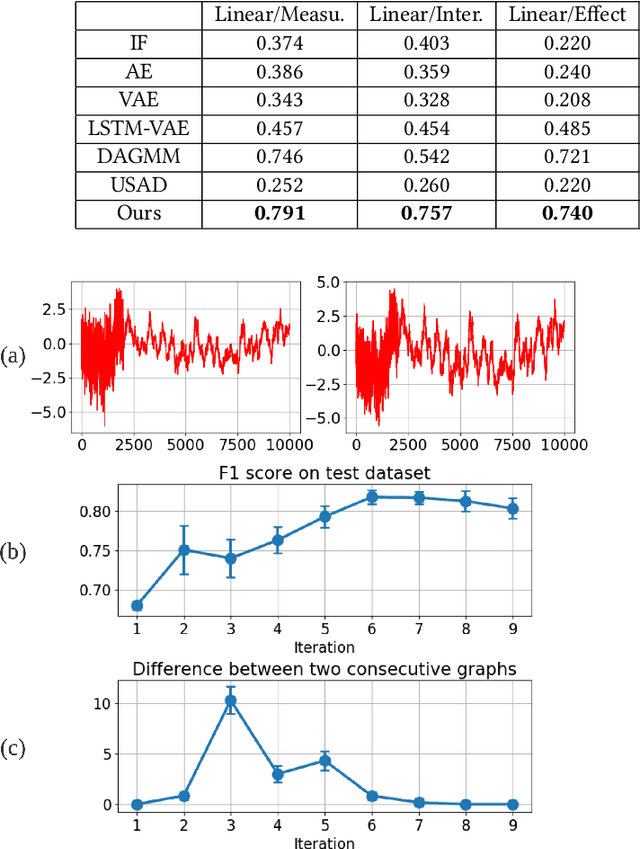
Abstract:Anomaly detection in multivariate time series plays an important role in monitoring the behaviors of various real-world systems, e.g., IT system operations or manufacturing industry. Previous approaches model the joint distribution without considering the underlying mechanism of multivariate time series, making them complicated and computationally hungry. In this paper, we formulate the anomaly detection problem from a causal perspective and view anomalies as instances that do not follow the regular causal mechanism to generate the multivariate data. We then propose a causality-based anomaly detection approach, which first learns the causal structure from data and then infers whether an instance is an anomaly relative to the local causal mechanism to generate each variable from its direct causes, whose conditional distribution can be directly estimated from data. In light of the modularity property of causal systems, the original problem is divided into a series of separate low-dimensional anomaly detection problems so that where an anomaly happens can be directly identified. We evaluate our approach with both simulated and public datasets as well as a case study on real-world AIOps applications, showing its efficacy, robustness, and practical feasibility.
OmniXAI: A Library for Explainable AI
Jun 09, 2022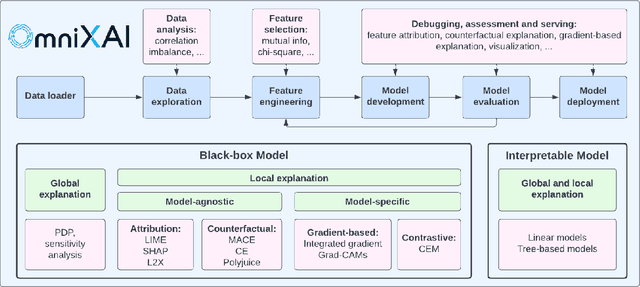
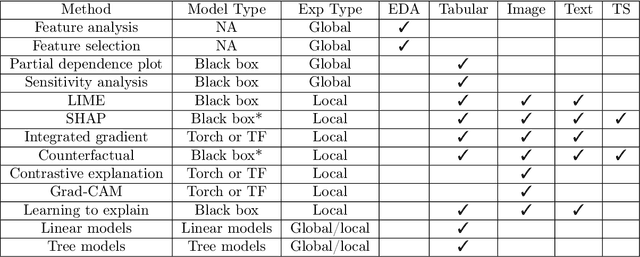
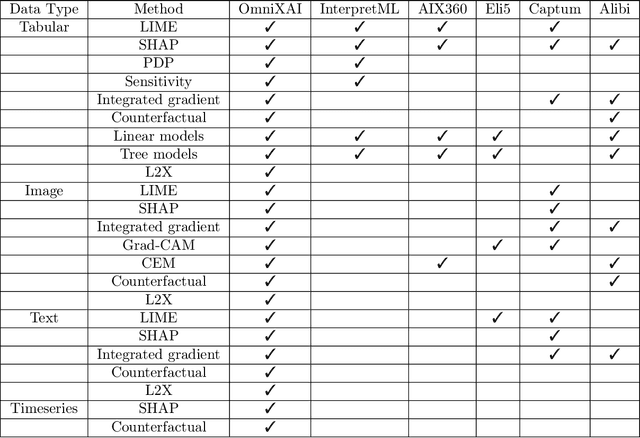

Abstract:We introduce OmniXAI (short for Omni eXplainable AI), an open-source Python library of eXplainable AI (XAI), which offers omni-way explainable AI capabilities and various interpretable machine learning techniques to address the pain points of understanding and interpreting the decisions made by machine learning (ML) in practice. OmniXAI aims to be a one-stop comprehensive library that makes explainable AI easy for data scientists, ML researchers and practitioners who need explanation for various types of data, models and explanation methods at different stages of ML process (data exploration, feature engineering, model development, evaluation, and decision-making, etc). In particular, our library includes a rich family of explanation methods integrated in a unified interface, which supports multiple data types (tabular data, images, texts, time-series), multiple types of ML models (traditional ML in Scikit-learn and deep learning models in PyTorch/TensorFlow), and a range of diverse explanation methods including "model-specific" and "model-agnostic" ones (such as feature-attribution explanation, counterfactual explanation, gradient-based explanation, etc). For practitioners, the library provides an easy-to-use unified interface to generate the explanations for their applications by only writing a few lines of codes, and also a GUI dashboard for visualization of different explanations for more insights about decisions. In this technical report, we present OmniXAI's design principles, system architectures, and major functionalities, and also demonstrate several example use cases across different types of data, tasks, and models.
MACE: An Efficient Model-Agnostic Framework for Counterfactual Explanation
May 31, 2022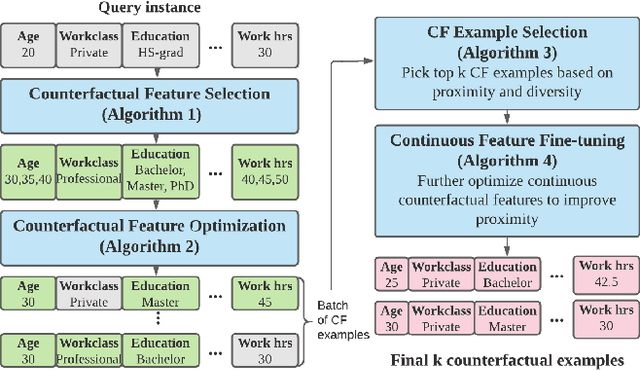
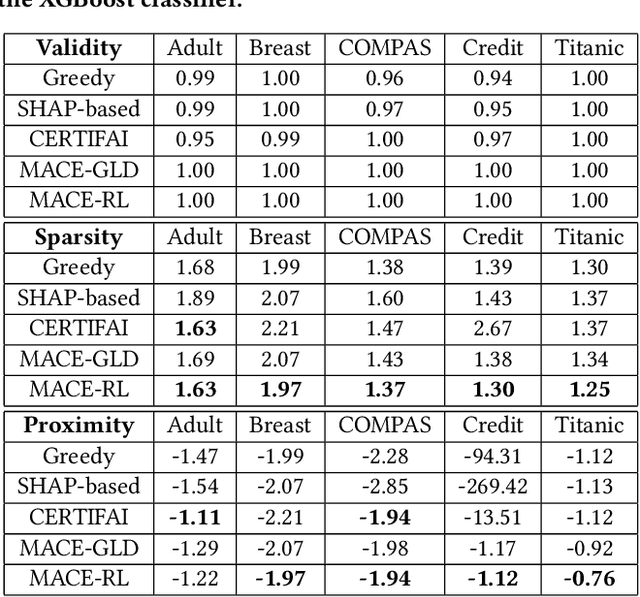
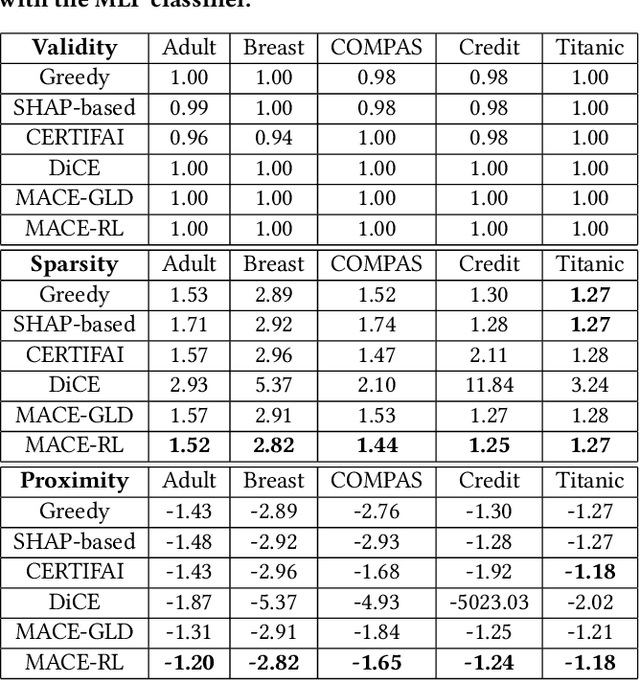
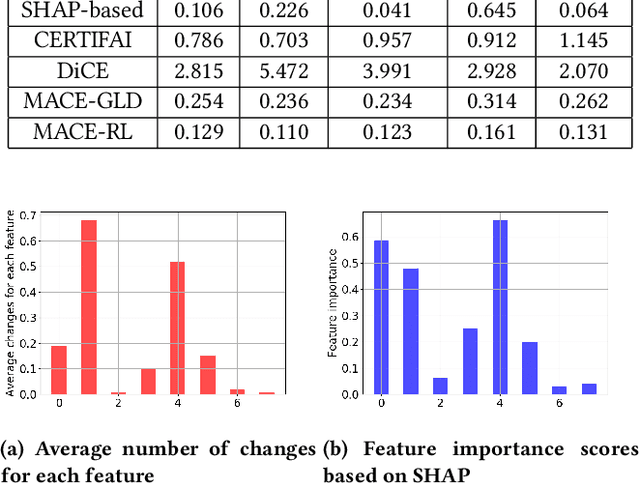
Abstract:Counterfactual explanation is an important Explainable AI technique to explain machine learning predictions. Despite being studied actively, existing optimization-based methods often assume that the underlying machine-learning model is differentiable and treat categorical attributes as continuous ones, which restricts their real-world applications when categorical attributes have many different values or the model is non-differentiable. To make counterfactual explanation suitable for real-world applications, we propose a novel framework of Model-Agnostic Counterfactual Explanation (MACE), which adopts a newly designed pipeline that can efficiently handle non-differentiable machine-learning models on a large number of feature values. in our MACE approach, we propose a novel RL-based method for finding good counterfactual examples and a gradient-less descent method for improving proximity. Experiments on public datasets validate the effectiveness with better validity, sparsity and proximity.
 Add to Chrome
Add to Chrome Add to Firefox
Add to Firefox Add to Edge
Add to Edge